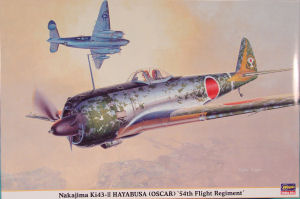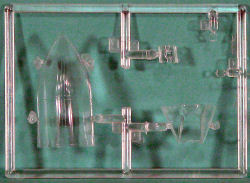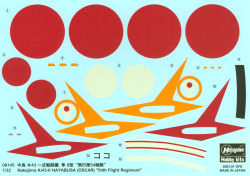
Hasegawa 1/32 Ki-43-II Hayabusa (Oscar) Kit First Look
By Michael Benolkin
| Date of Review | July 2007 | Manufacturer | Hasegawa |
|---|---|---|---|
| Subject | Nakajima Ki-43-II Hayabusa (Oscar) | Scale | 1/32 |
| Kit Number | 08145 | Primary Media | Styrene |
| Pros | Easy build, nice details | Cons | |
| Skill Level | Basic | MSRP (USD) | $36.99 |
First Look
 |
 |
 |
 |
 |
The Nakajima Ki-43 was Nakajima's answer to the Mitsubishi Zero - it too was an agile lightweight fighter that was destined for Imperial Japanese Army Air Force service while the Zero was designed for the Imperial Japanese Navy.
In the early days of World War II, the Ki-43 enjoyed the same advantages in aerial combat as the Zero - high performance and agility. And like the Zero, the high performance wasn't from a powerful engine, it was from its lightweight airframe. As newer allied aircraft entered the theater, the Achilles' Heel of both aircraft would come to light - lack of armor protection and marginal self-sealing fuel tanks.
The Ki-43-I was armed with only a pair of 7.7mm machine guns, again sufficient when countering inferior targets. These were upgraded to a pair of 12.7mm machine guns in later versions, but these too were minimalistic when allied fighters were armed with the same caliber guns, but with four or six per aircraft, not just two.
Many Ki-43s survived the war to continue service in other air arms including China, Thailand, Indonesia, France (in Indonesia) and even North Korea.
Here is one of Hasegawa's bread and butter kits. Molded in light gray styrene, the kit is presented on three parts trees plus a single tree of clear parts for the canopy and windscreen. This kit is older tooling, so its panel lines and rivet details are fine, but raised.
While the cockpit interior is minimalistic, there are aftermarket options including an early set (32047) from Eduard to dress up the details.
On the other hand, this kit represents a few bold steps forward in terms of detailing options. First, the radial engine is not your typical front and back halves. Instead, each crankcase is molded separately as are each of the seven cylinder heads. Build both of them up and you have a the fourteen cylinder Nakajima Ha-115 radial engine. The engine even has intake and exhaust manifolds included.
The kit provides another innovation that is more common today, but was relatively new then - your choice of open or closed cowl flaps. The kit provides two different carburetor intake scoops, depending on which aircraft you're building.
Kit options include:
- Seated pilot figure
- External drop tanks
- A pair of bombs
- Positionable canopy
- Choice of open or closed cowl flaps
- Choice of carburetor intakes
Markings are provided for two aircraft:
- Ki-43-II Hayabusa, 54th Sentai, 2nd Chutai, as flown by Captain Kitakoga Yukichi, 1944
- Ki-43-II Hayabusa, 54th Sentai, 3rd Chutai, as flown by Captain Hisashi Koshiishi, 1944
While Hasegawa (or someone else) may offer a new-tool Ki-43 in this scale with more contemporary detailing, this kit is still very nice and also commands a low street price as well. On the other hand, some of the 'limited edition' re-runs of this kit are now showing up at twice the price.
I bought this kit from one of our new sponsors, HobbyBuy.com. I was pleasantly surprised to see this kit listed in their 50% off section and picked it up for a mere $18.50. What's more, I was VERY impressed with their reasonably priced shipping and automated email tracking via FedEx the whole way. Now THAT is service!







